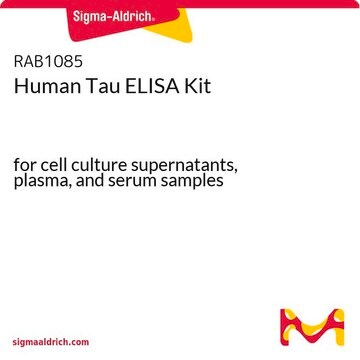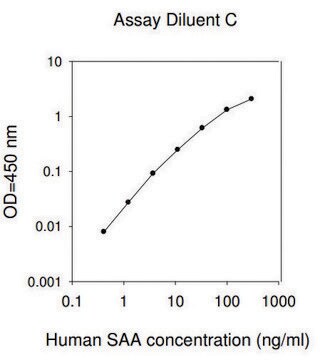EZHS40
Human Amyloid β40 ELISA Kit
measures and quantifies Amyloid β40 levels in 50 μL CSF, cell culture supernatent or plasma
Sinonimo/i:
Amyloid-beta protein 40
About This Item
Prodotti consigliati
Nome del prodotto
High Sensitivity Human Amyloid β40 ELISA, This High Sensitivity Human Amyloid β40 ELISA is used to measure & quantify Amyloid β40 levels in Neuroscience research.
Livello qualitativo
Reattività contro le specie
human
Confezionamento
kit of 1 × 96 wells
Parametri
50 μL sample volume (Overnight assay)
assay range
sensitivity: 6.0 pg/mL
(50 μl sample size)
standard curve range: 16-500 pg/mL
tecniche
ELISA: suitable
input
sample type plasma (K2 EDTA)
sample type serum
sample type cerebrospinal fluid (CSF)
applicazioni
research use
Metodo di rivelazione
colorimetric (450nm/590nm)
Condizioni di spedizione
wet ice
Temperatura di conservazione
2-8°C
Informazioni sul gene
human ... APP(351)
Descrizione generale
Specificità
Applicazioni
Neuroscience
Alzheimer′s Disease
Stoccaggio e stabilità
Altre note
Esclusione di responsabilità
Raccomandato
Avvertenze
Warning
Indicazioni di pericolo
Consigli di prudenza
Classi di pericolo
Aquatic Chronic 3 - Met. Corr. 1 - Skin Sens. 1
Codice della classe di stoccaggio
8A - Combustible corrosive hazardous materials
Certificati d'analisi (COA)
Cerca il Certificati d'analisi (COA) digitando il numero di lotto/batch corrispondente. I numeri di lotto o di batch sono stampati sull'etichetta dei prodotti dopo la parola ‘Lotto’ o ‘Batch’.
Possiedi già questo prodotto?
I documenti relativi ai prodotti acquistati recentemente sono disponibili nell’Archivio dei documenti.
Il team dei nostri ricercatori vanta grande esperienza in tutte le aree della ricerca quali Life Science, scienza dei materiali, sintesi chimica, cromatografia, discipline analitiche, ecc..
Contatta l'Assistenza Tecnica.








